The McKenzie's Official world tour site
| | Sun | Mon | Tue | Wed | Thu | Fri | Sat |
|---|
| 26 | 27 | 28 | 29 | 30 | 31 | 1 | | 2 | 3 | 4 | 5 | 6 | 7 | 8 | | 9 | 10 | 11 | 12 | 13 | 14 | 15 | | 16 | 17 | 18 | 19 | 20 | 21 | 22 | | 23 | 24 | 25 | 26 | 27 | 28 | 29 | | 30 | 31 | 1 | 2 | 3 | 4 | 5 |
Search
Navigation
Categories
|

Saturday, 29 August 2009
ALASKA!!
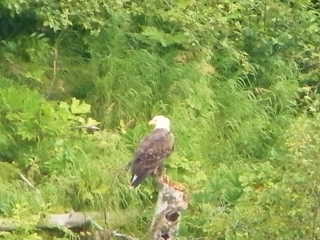
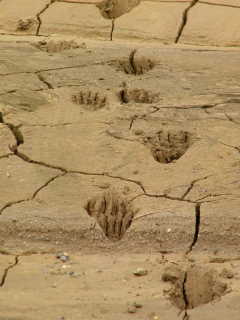
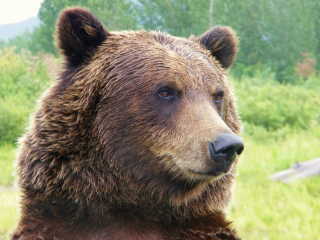

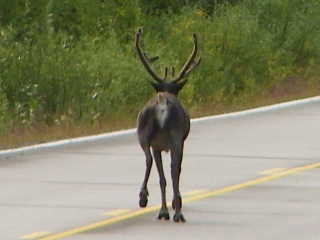

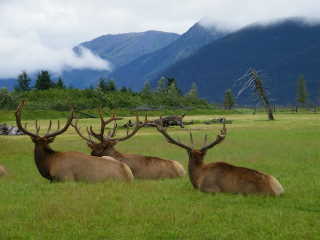
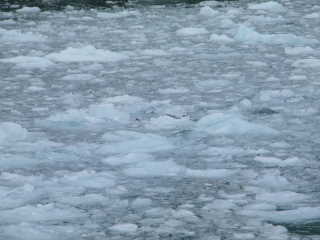
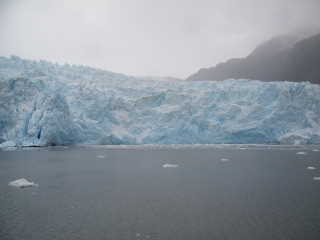
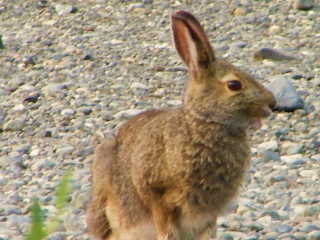

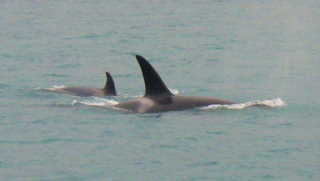
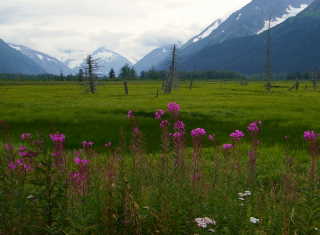

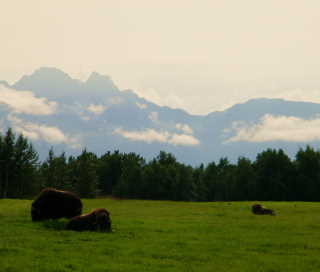
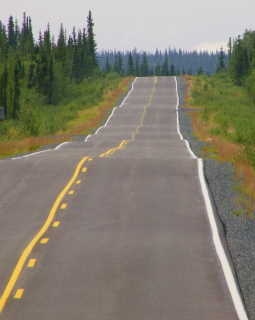 Saturday, 29 August 2009 06:50:51 (GMT Daylight Time, UTC+01:00)
Saturday, 29 August 2009 06:50:51 (GMT Daylight Time, UTC+01:00)  Alaska
Facts and more facts.....
Alaska
Facts and more facts.....
FACTOIDS:
• Alaska is 586,000 square miles and in the Aleut language, Alaska means “The Great Land”.
• Alaska is one-sixth the size of the Lower 48 (the other states of the USA), and with 30,000 miles of coast- line, it has more coastline than the rest of the states combined.
• Alaska has 54 million acres dedicated to 17 national parks, which is 13% of the state’s landmass!
• There is 29,000 square miles of ICE in Alaska! That is 5% of Alaska!
• Alaska celebrates its 50th birthday of being a State in 2009!
• Cheechako – describes a new-comer, generally someone who hasn’t spent a winter in Alaska.
• Sourdough – Any Alaska or Yukon old-timer.
• James Cook first explored Cook Inlet in 1778. He also reached Hawaii that same year.
• The Musk Ox has survived since the ice age. It is able to survive the harsh arctic winter temperatures by growing a thick layer of QIVIUT (pronounced Ki-vee-ute) over their entire body. This fine under wool is shed in the spring when it is no longer needed. They have the warmest fur of any animal (8 times warmer than sheep’s wool!) The Musk Ox farm at Palmer is the only place in the world to gather this wool and send it away to be made into something useful (scarves, hats etc). This fibre is one of the warmest and rarest on earth and feels extremely light.
• The Alaska Wildlife Conservation Centre is a non – profit organisation dedicated to preserving Alaska’s wildlife through conservation, education and quality animal care (www.awcc.org). The centre takes in orphaned and injured animals year round. Animals that cannot be released back into the wild are given a permanent home there.
• Seward is known as the land which has been carved by glaciers and polished by the sea. It has tidewater glaciers that thunder into the sea.
• The city of Seward was named for President Lincoln’s Secretary of State, William Henry Seward, the man who engineered the purchase of Alaska from Russia in 1867.
• In 1867 the USA paid 7.2 million dollars to Russia for the purchase of Alaska. This was equal to 2 cents per acre (roughly 1 penny per acre).
• The Harding Ice field is the largest within the USA boundaries. It spans a massive area of 70 miles long and 30 miles wide.
• The Kenai Fjords National Park consists of 600,000 acres!
• In Alaska law, motorcyclist must wear a helmet only until they are 18, however any age passenger must always wear a helmet.
• Anchorage is home to half of the State of Alaska’s population.
• Almost 30,000 Alaskan natives live in the Anchorage area. The largest native village in the State (Eklutna) is found here.
• At least 1000 moose live within the Anchorage City Limits!
• The 730,000 acre Tetlin Wildlife Refuge produces up to 100,000 ducklings a year. There are also over 186 different bird species here.
• In some parts of Alaska there are some days which are considered just TOO COLD for school. Usually the cut off point is around 50-55 degrees F -below zero – BUT – not in TOK, where school goes on no matter what the temperature! (-80 degrees F?!)
• A working sled dog needs up to 10,000 calories a day during the Iditarod sled dog race to Nome. Dogs in Alaska traditionally ate dried and frozen salmon during the winter.
Saturday, 29 August 2009 06:42:44 (GMT Daylight Time, UTC+01:00)  Alaska
Wildlife wonders..............
Alaska
Wildlife wonders..............
WILDLIFE FACTOIDS:
• GRIZZLY BEARS- can weigh up to 800-1500 pounds and range in colour all shades from blonde to black. They have a shoulder hump and a dished face. 70-80% of their diet is plants and they use very long blunt claws to dig. The rest of their diet is made up from small mammals, and salmon! Grizzly bears have difficulty in climbing trees but are still reach heights of 12 feet up a tree trunk! While they sleep in the winter, their heart beat drops from 70 beats to around 10 beats a minute. They recycle stored fat, carbohydrates and muscle proteins in a way that allows them to survive without eating or drinking for months.
• BLACK BEARS – can weigh 220-330 pounds, and also range in colour from black to brown to blonde. They have no shoulder hump and shorter claws. 95% of their diet is plant material. Black bears loose 20-40% of their body weight during winter hibernation and so they must consume 20,000 calories per day prior to hibernation! During those winter months they ‘den’ in caves or hollow trees. This is where their tiny cubs are born, and where they are nursed until they emerge from their dens in the spring.
• MOOSE –are the largest member of the deer family. They have very long legs, a humpback, a short tale, and a flap of covered skin that hangs beneath their chin (called a bell). Males are the only ones to have antlers. Moose can swim continuously for several hours, dive down to depths of 20 feet, and remain submerged for up to a minute!
• ELK – resemble very large white-tailed deer. They weigh 660-770 pounds fully grown and males have large antlers. Elks are highly vocal animals, they bark to warn each other of danger and communicate by grunting and squealing to each other.
• CARIBOU – Both male and females grow antlers, however the males antlers are massive, in comparison to the females. Their favourite winter food of lichens, grow very slowly, but the caribou’s erratic movements keep it from becoming overgrazed. They have large hooves that keep them above snow through the winter months and paw through the snow in search of lichens. There are over a million caribou in Alaska.
• BISON- can be recognised by their dark brown, shaggy furred head, lighter coloured body, massive humped shoulder and sharp upturned horns. If Bison are caught in a storm, they will face the wind, using their woolly head and shoulder coat to reduce the chill, before it reaches the rest of the body.
• TUFTED PUFFINS- inhabit burrows.
• HORNED PUFFINS- occupy naturally occurring rock crevices.
• DALL SHEEP – live in high, alpine tundra on ridges. They eat grasses, lichens and moss. Rams have large, curling horns which grow to a ‘full curl’ in eight years.
• WOLVES – are social animals and live in packs of six or seven. They eat animals ranging from tiny voles and ground squirrels to caribou and moose.
• AMERICAN WOOD FROGS- freeze solid during the winter, even their blood and eye balls, and their hearts stop beating. They replace much of the water inside their cells with glucose and create their very own antifreeze so that their cell walls are not permanently damaged. Within hours, as temperatures rise in the spring – these frogs thaw out and hop away as if nothing has happened – how is this possible?
• SEA OTTERS – are an endangered species in western Alaska. It is the smallest marine mammal and the largest member of the weasel family. They like to eat crabs, clams, sea urchins and octopus. Sea otters have the densest fur in the animal kingdom; up to a million hairs per square inch!
• BALD HEADED EAGLES- are the symbol of the USA. They opportunistically eat other birds, fish and carrion. They have a majestic and proud beauty.
• HARBOR SEALS- are members of the true seal family and have no external ear flaps. They eat fish such as Capelin and swimming crustaceans, such as shrimp.
• HUMPED BACK WHALES – exhales water at over 300 mph (480 kph) in a fine spray. They surface every 5 to 8 minutes before diving to continue their 18 –hour-long feeding. Females must consume about 800 pounds (360 kgs) of krill and schooling fish a day, sieved through baleen instead of teeth, to support their 90,000 pound (41,000 kg) weight. A whale fluking (lifting its tail out of the water) is beginning a deep dive down and saying in Whale language “diving deeper; see you later!”
Saturday, 29 August 2009 06:41:15 (GMT Daylight Time, UTC+01:00)  Alaska
Alaska

Friday, 21 August 2009
Anchorage and onwards...........
Lake Louise was beautiful and even featured an island with a few houses on it! We were lucky to see a caribou (with antlers) walking along the road in front of Nessie!
In Palmer we visited the Musk Ox Farm and found out about these animals that existed in the ice age and have a woolly coat that will continue to keep them warm at a temperature of minus 80 degrees! They are not as big as bison and look like a cross between a highland cow and an ox. We could also imagine these animals to be happy up in the Scottish Highlands. We enjoyed staying at the Town and Country RV Park in Palmer and learnt more about the Glenn Highway which is now a National Scenic Byway.
Our last stop before reaching Anchorage was at the Eagle River Park where the children collected more fire wood for a campfire.
When we got into Anchorage, we stayed at a camp near to the airport as we were collecting a very special guest early the next day. We sorted out Nessie to accommodate another person, as our very good friend Chelle has flown in via New York and will spend 10 days travelling Alaska with us.
We thought that it might add a different flavour if Chelle contributes to the blog for the time she is with us, as a visitor joining in with life on Macswayround!!
Over to you -Chelle – and many thanks for your thoughts and hard work.
It was great to see you again.
Friday, 21 August 2009 09:27:48 (GMT Daylight Time, UTC+01:00)  Alaska
Anchorage and onwards...........
Alaska
Anchorage and onwards...........
I joined the McKenzie family in their travels around the world on the 11th August 2009, I had promised when they left England, on July 14th 2008, that wherever they were in the world in August 2009 I would visit them.
As I arrived in Anchorage airport I had been travelling for 17 hours as I had to fly from New York to Seattle then onto Anchorage. As I came out of the airport I saw the RV disappearing out of the exit of the car park, with ‘MACSWAY ROUND’ clearly visible heading over the horizon. I checked my phone no signal, help I didn’t know anyone, I had nowhere to stay, this trip was beginning to look like a bad idea. As I started to panic the RV came into sight again, I waved, legged it to the taxi rank pink case in toe and met the family. They all had a giggle about my pink Barbie case, but it was a great reunion.
Phil then drove us to a nearby broad walk so I could settle in to ‘Nessie’. I had not been camping for a long time and proceeded to break the toilet within the first 5 minutes of arriving, but Phil and Sharon were very understanding and gave me the guided tour of ‘Nessie’ which they have very much made their home and it felt very welcoming.
Ben and Jemma were then keen to show me the wildlife and they have learnt an amazing amount in their travels about the natural environment, the animals and their habitat. After an entertaining walk we then headed for Seward, setting up camp for the night at Chugach National Forest at Granite Creek campground. Ben and Jemma showed me where to get the best fire wood and what to do if we saw a bear. They also told me about the pepper spray I needed to carry in case we came across a bear. It was like being on tour with two young BBC wildlife presenters!!
After some much needed sleep we then travelled to Seward. Ben and Jemma then managed to complete the Kenai Fjords Junior Ranger booklet which involved many activities which entitled them to become junior rangers. They have been collecting these badges in all National Parks around the USA, they now have quite a collection of which they are very proud and rightly so!!
The next part of our journey in Seaward took us to ‘Exit Glacier’ this was just outside of Seward and this gave us the opportunity to walk to a glacier which was just amazing. It was enormous and really brought the process of glaciation to life. I hope that if Ben and Jemma study geography in future years they will have more of an appreciation of this phenomenon than I did at school having only been able to look at a book, as it really was truly spectacular.
There was great excitement in ‘Nessie’ the next morning as we prepared to board ‘Kenai Star’ which was the boat which would take us right into the heart of the Kenai Fjords National Park. We had been promised we would see a variety of marine life while we were on board and we were not disappointed.
We had been on board approximately 20 minutes and we saw a sea otter, lying on its back very chilled out watching the world go by. Soon after we spotted the hump back whale, which was amazing to see. Ben informed me at this point that the Blue Whale’s tail is the width of a small aircraft. Who needs David Attenborough on tour when you have Ben McKenzie ?? Capturing this magnificent creature on camera was however a different matter and it became a game of whale waiting not watching but we all got some excellent shots including Jemma.
Hunger by now had set in and we were all very glad to see lunch was being served it was salmon and steak, with salad as much as you could eat. It was delicious and comes highly recommended by us all. Soon after lunch the boat was buzzing once again, as the captain had informed us that he had spotted a killer whale. This was music to Ben’s ears I will never forget the look on his face as he ran to get the best view. The Killer Whale was better than we could have imagined and we were all in awe of this glorious mammal.
Holgate Glacier loomed on the horizon as we sailed further into the Kenai National Park. We waited in anticipation as we heard the glacier cracking to calve ice bergs into the fjord, we were lucky enough to see some small pieces of ice slip into the sea. The cruise had been a huge hit with all of us and as we travelled onwards towards our next stop we spent many hours reminiscing over what we had seen on that journey.
Alaska Wildlife Conservation Centre was to be the next destination and although all the animals we saw were not in the wild they were in very large open spaces. The grizzly bears four of them had 18 acres so we were lucky to see them, along with moose, bison, caribou, black bears and elk.
We were then heading for the Denali highway and we set up camp alongside a river, unknown to us on a Friday night it was a local spot for bikers, however they were very friendly and interested in the family’s adventure. Wherever we go people are always keen and eager to know where the family have been and why they have embarked on the journey, and why Phil is travelling with two women. (He has given various replies!!!) Unfortunately that night I had a nightmare about the RV flooding and woke the whole family with a loud shout. Phil then decided to put on a night light on each night for me, how embarrassing a grown adult having to sleep with a night light – but it keeps Phil happy !!
Denali Highway was an experience it is over 100 miles long with only 25 miles with a tarmac surface the rest is rough track. Driving Nessie on this road was both challenging and tiring but Phil did a great job. We unfortunately did not see any bears but we did spot caribou and moose in the wild. We also camped in the wilderness which was a great experience.
Denali National Park was a beautiful national park we also visited and once again saw more of Alsaka’s wildlife along the Savage River. This included a marmont, ptarmigan, wild grouse and a coyote. Once again I was amazed at the family’s knowledge about the wildlife we saw.
We are now heading for Anchorage as my trip draws to an end and what an inspirational trip it has been, the McKenzie family have allowed me to join them for a short time on what is an evolving journey in which destinations are only a small part of the world they are living in. They have found great happiness in all they have done and I thank them greatly for having given me the chance to be a part of this fascinating exploration into the unknown.
Chelle x
PS – If you have not yet made a donation to the Devon Air Ambulance which is the fund raising element of this trip, I would encourage you to do so. This is a way you can recognise the achievements of the family and celebrate their success to date !!
Friday, 21 August 2009 09:20:59 (GMT Daylight Time, UTC+01:00)  Alaska
Alaska

Sunday, 09 August 2009
Watson Lake and up.......in pictures
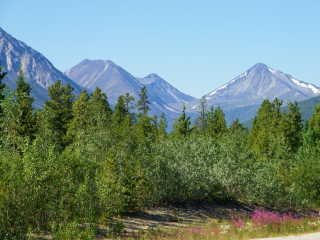
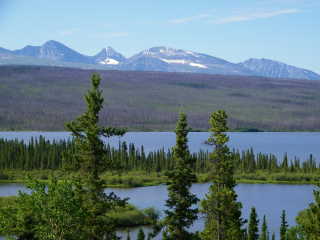
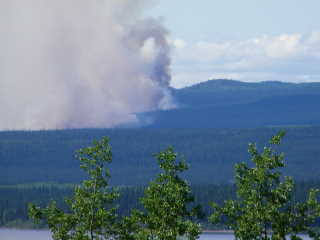

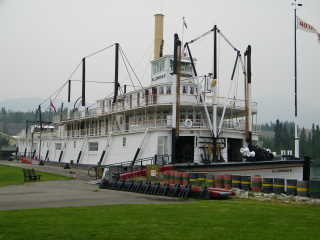
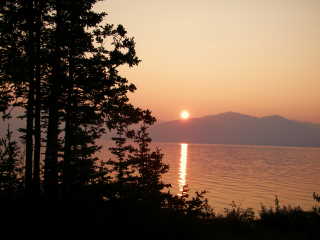
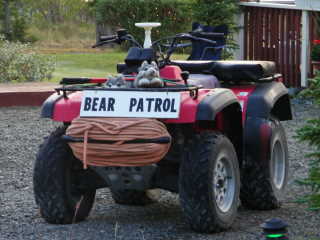

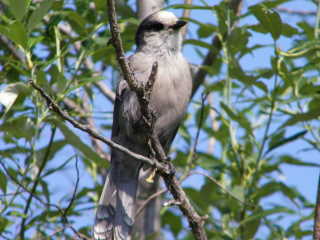
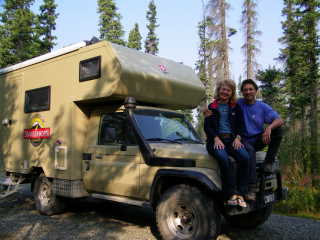
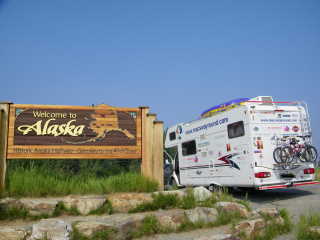
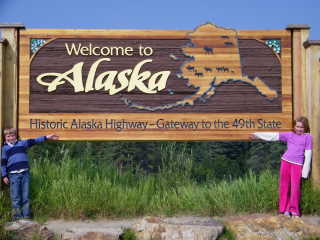

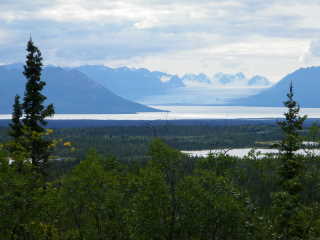 Sunday, 09 August 2009 21:47:49 (GMT Daylight Time, UTC+01:00)
Sunday, 09 August 2009 21:47:49 (GMT Daylight Time, UTC+01:00)  Alaska
Watson Lake and up.......
Alaska
Watson Lake and up.......
Upon leaving Watson Lake, everyone was suffering from a lack of sleep – due to those darn mosquitoes.....the bites down by the river side on our way to see the bison took us all by surprise.....and we sure have learnt our lesson from that experience!
Driving through Yukon, we found the Continental Divide Lodge and decided to call it a day......we got a warm welcome there and gave Nessie a well deserved bath! We enjoyed a tasty meal in the restaurant, as a treat, and were then all asleep by 9.30pm!
Leaving the Continental Divide, we all felt much brighter having slept well and we enjoyed the beautiful colours of the flowers and the back drop scenery as we drove towards Whitehorse. We saw a big fire on the other side of the Swan River to us. We are not sure if it was controlled or wild, but at least the temperature was not too high and it was not too windy. At Whitehorse, we stopped to talk to Julie as her bike had a BRITISH number plate! It was strange to see and she explained that 17 of them were on a tour from Alaska right down to South America (Patagonia). One of the group was from Devon and also fundraising for the Devon Air Ambulance – as we are. So it really is a small world... We wish them all luck in their adventures! We set up camp at the Hi Country RV Park and enjoyed meeting Roef and Ina from Germany. They have also shipped their own Mercedes Camper over to the States and have given us the details of different options to consider for our return journey, later on this year. Following more sightings of the majestic Bald Headed Eagle along the Alaska Highway, we arrived at Cottonwood RV Park. We were interested to learn that the council run site just a little further along this road had been closed the day before – due to the presence of Grizzly Bears! A little unusual with us coming from England and all!
We spent the afternoon and evening cooking up many meals as we were told that we would not be allowed to take any meat over the border, into Alaska. We had a large choice of menu for the next couple of days, and our final campsite in Canada was Lake Creek, until we were ready to proceed with our journey! Jemma and Ben picked wild strawberries and wild raspberries (getting there before the bears!) and we mixed them into a concoction for our pudding that evening! We met Walter and Ruth from Switzerland, who have their own all- terrain vehicle with them and are also well- seasoned travellers! We didn’t realise how popular this travelling way of life can be – until we have been in the midst of it all! It seems to be a bug that sticks with you always.....and you just need to see more! We have had our body clocks thrown out once again by heading north. It was still light at midnight and very unnatural for us to have to sleep. The children’s bedtimes have become very tricky but we are glad Nessie has night blinds! It has also got colder and we registered -2 degrees in the morning!
Over the border and into ALASKA! We have made it to the ‘last new place’ for us to visit on Macswayround! Quite fitting as Alaska is referred to as ’The Last Frontier’ and also – ‘The Land of the Midnight Sun’ – and we can vouch for that too! It all seems to have gone so quickly.....but it hasn’t gone yet – still much more to see and do on Macswayround!
Our first campsite was ‘Deadpan’s Lake’ at Northway Junction. Although we didn’t know quite what to make of this name, the children had a great time in the water and with the dingy too! We later found out from Ranger Adriana that a few men had enjoyed themselves (a bit too much), one night, as they worked on constructing the Alaska Highway, and one man had actually drowned in this lake. Adriana also did a presentation on the Boreal Forest with many stories about the area. She showed us how to recognise, amongst others, Black Spruce, White Spruce, Willow and Quaking Aspen trees. We heard about a grizzly bear encounter not too far from us, the night before, and about Adriana’s own hiking and camping experiences – with the bears! We figure that the locals must treat the bears around here with the same degree of normality as the Australians treat crocodiles and sharks! As we were leaving the area, we came across Christie (the same signal board lady who we met the day before, our first Alaskan local!) – she also told us the story of the ‘bear’ and said that the trashed house was that one – just over the road from us. She was, and understandably so, being extra careful in checking behind her back on that particular day!
We found out about severe wild fires burning throughout Alaska at the moment. The numbers change frequently but there were 79 active fires in progress the other day. This has made much of the country very smoky, which can limit views for everyone. We now realise that the fires we have been seeing already (within the Yukon Territory also) are wild fires. This brings back memories of when we were in Australia earlier this year, and the wild fires burning there – where many lives were lost. Alaska also has such an immense coverage of land that hundreds of thousands of acres can continue burning without being of threat to anyone and fire is a necessary part of the forests regeneration cycles. Obviously these fires are closely monitored and defence systems are installed around the towns when deemed necessary. Speaking with the locals, wild fires are obviously another natural and regular occurrence, here in Alaska. However, this year is particularly bad for the extreme number and enormous size that some of the fires have reached. Some fires have met and joined forces making their power ever stronger and more ferocious. We have seen a fire helicopter (near Whitehorse), collecting water from a nearby lake.....it seems that where-ever we go on Macswayround – we are experiencing dramatic climate change, with fires, floods and extreme temperatures.
In Tok, we stayed at the RV Village and chatted to Pieter & Monique from the Netherlands, who have been travelling for about 7 years, to date (popping home from time to time!).We went to the entertainments at the camp which included songs and tales of Alaska with Dave Stancliff and his team of budding musicians. There is a magical appeal to the spirit and feelings that time in Alaska brings and these are the themes (among others) that Dave has expressed through his song writing. He also has a fun song about a moose – which has been echoed throughout Nessie ever since his show!
We had a very interesting time at the Tetlin National Wildlife Refuge Headquarters and we would like to thank the staff there for their time. The children received booklets, on a similar theme to the Junior Ranger work – however completion of this work will make the children Refuge Managers (through the U.S Fish & Wildlife Service).
It rained heavily for a short while, and we are only hoping that this would have helped to control some of the fires ....... At the Dry Creek Camp, we met Leo and the children enjoyed roasting marshmallows in his controlled fire pit. We learnt more local knowledge, although after being up here 30 years Leo is still not sure if he is a local (this sounds like Devon or Cornwall!)
In the morning we were even offered pancakes for breakfast.....thank-you- they were yummy!!
ONWARDS AND UPWARDS – in this land of the midnight sun...........
Sunday, 09 August 2009 20:58:13 (GMT Daylight Time, UTC+01:00)  Alaska | Canada
Watson Lake and up.......
Alaska | Canada
Watson Lake and up.......
FACTIODS:
• The Continental Divide is the ridge line that separates two of the largest river drainages in North America. The Alaska Highway crosses the divide at one of the lowest points. Only humps of sand and gravel separate the west-flowing Swift River from the east-flowing Rancheria River. A leaf dropped into the Rancheria River would take a long course of 2,650 miles to end up in the Arctic Ocean. However, a leaf dropped into the Swift River would travel 2,300 miles and end up in the Pacific Ocean.
• The Bald Eagle is found only on the North American continent. Adults generally weigh between 9 and 12 pounds and have wing span of 7 feet. The district white head and tail of the mature bird is developed between 4 and 6 years of age.
• The Boreal Forest is very special as it runs along the same latitude, in a band, all around the world. It extends across the subarctic regions of Russia, Scandinavia and North America. Each of these forests has the same varieties of trees, mostly coniferous, which all do a very important job around our world.
• Arctic Tundra is usually defined as the land beyond the northern limit of tree growth. However, in the Yukon, arctic tundra may contain strands of the Boreal forest almost to the arctic coast.
Sunday, 09 August 2009 20:57:09 (GMT Daylight Time, UTC+01:00)  Alaska | Canada
Watson Lake and up.......
Alaska | Canada
Watson Lake and up.......
WILDLIFE HITS:
• Stone Mountain Sheep
• Caribou
• Black Bear!
• Bison (buffalo)
• Trumpeter Swans
• Pine Gros Beak
• Grey Jays (Camp-robbers!)
• Grayling (Lady of the Stream).
Sunday, 09 August 2009 20:55:59 (GMT Daylight Time, UTC+01:00)  Canada | Alaska
Canada | Alaska

Thursday, 06 August 2009